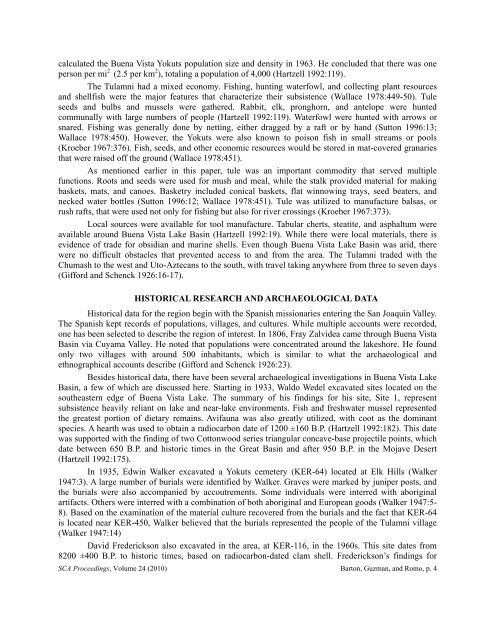at the bead hill site - Society for California Archaeology
at the bead hill site - Society for California Archaeology
at the bead hill site - Society for California Archaeology
You also want an ePaper? Increase the reach of your titles
YUMPU automatically turns print PDFs into web optimized ePapers that Google loves.
calcul<strong>at</strong>ed <strong>the</strong> Buena Vista Yokuts popul<strong>at</strong>ion size and density in 1963. He concluded th<strong>at</strong> <strong>the</strong>re was one<br />
person per mi 2 (2.5 per km 2 ), totaling a popul<strong>at</strong>ion of 4,000 (Hartzell 1992:119).<br />
The Tulamni had a mixed economy. Fishing, hunting w<strong>at</strong>erfowl, and collecting plant resources<br />
and shellfish were <strong>the</strong> major fe<strong>at</strong>ures th<strong>at</strong> characterize <strong>the</strong>ir subsistence (Wallace 1978:449-50). Tule<br />
seeds and bulbs and mussels were g<strong>at</strong>hered. Rabbit, elk, pronghorn, and antelope were hunted<br />
communally with large numbers of people (Hartzell 1992:119). W<strong>at</strong>erfowl were hunted with arrows or<br />
snared. Fishing was generally done by netting, ei<strong>the</strong>r dragged by a raft or by hand (Sutton 1996:13;<br />
Wallace 1978:450). However, <strong>the</strong> Yokuts were also known to poison fish in small streams or pools<br />
(Kroeber 1967:376). Fish, seeds, and o<strong>the</strong>r economic resources would be stored in m<strong>at</strong>-covered granaries<br />
th<strong>at</strong> were raised off <strong>the</strong> ground (Wallace 1978:451).<br />
As mentioned earlier in this paper, tule was an important commodity th<strong>at</strong> served multiple<br />
functions. Roots and seeds were used <strong>for</strong> mush and meal, while <strong>the</strong> stalk provided m<strong>at</strong>erial <strong>for</strong> making<br />
baskets, m<strong>at</strong>s, and canoes. Basketry included conical baskets, fl<strong>at</strong> winnowing trays, seed be<strong>at</strong>ers, and<br />
necked w<strong>at</strong>er bottles (Sutton 1996:12; Wallace 1978:451). Tule was utilized to manufacture balsas, or<br />
rush rafts, th<strong>at</strong> were used not only <strong>for</strong> fishing but also <strong>for</strong> river crossings (Kroeber 1967:373).<br />
Local sources were available <strong>for</strong> tool manufacture. Tabular cherts, ste<strong>at</strong>ite, and asphaltum were<br />
available around Buena Vista Lake Basin (Hartzell 1992:19). While <strong>the</strong>re were local m<strong>at</strong>erials, <strong>the</strong>re is<br />
evidence of trade <strong>for</strong> obsidian and marine shells. Even though Buena Vista Lake Basin was arid, <strong>the</strong>re<br />
were no difficult obstacles th<strong>at</strong> prevented access to and from <strong>the</strong> area. The Tulamni traded with <strong>the</strong><br />
Chumash to <strong>the</strong> west and Uto-Aztecans to <strong>the</strong> south, with travel taking anywhere from three to seven days<br />
(Gif<strong>for</strong>d and Schenck 1926:16-17).<br />
HISTORICAL RESEARCH AND ARCHAEOLOGICAL DATA<br />
Historical d<strong>at</strong>a <strong>for</strong> <strong>the</strong> region begin with <strong>the</strong> Spanish missionaries entering <strong>the</strong> San Joaquin Valley.<br />
The Spanish kept records of popul<strong>at</strong>ions, villages, and cultures. While multiple accounts were recorded,<br />
one has been selected to describe <strong>the</strong> region of interest. In 1806, Fray Zalvidea came through Buena Vista<br />
Basin via Cuyama Valley. He noted th<strong>at</strong> popul<strong>at</strong>ions were concentr<strong>at</strong>ed around <strong>the</strong> lakeshore. He found<br />
only two villages with around 500 inhabitants, which is similar to wh<strong>at</strong> <strong>the</strong> archaeological and<br />
ethnographical accounts describe (Gif<strong>for</strong>d and Schenck 1926:23).<br />
Besides historical d<strong>at</strong>a, <strong>the</strong>re have been several archaeological investig<strong>at</strong>ions in Buena Vista Lake<br />
Basin, a few of which are discussed here. Starting in 1933, Waldo Wedel excav<strong>at</strong>ed <strong>site</strong>s loc<strong>at</strong>ed on <strong>the</strong><br />
sou<strong>the</strong>astern edge of Buena Vista Lake. The summary of his findings <strong>for</strong> his <strong>site</strong>, Site 1, represent<br />
subsistence heavily reliant on lake and near-lake environments. Fish and freshw<strong>at</strong>er mussel represented<br />
<strong>the</strong> gre<strong>at</strong>est portion of dietary remains. Avifauna was also gre<strong>at</strong>ly utilized, with coot as <strong>the</strong> dominant<br />
species. A hearth was used to obtain a radiocarbon d<strong>at</strong>e of 1200 ±160 B.P. (Hartzell 1992:182). This d<strong>at</strong>e<br />
was supported with <strong>the</strong> finding of two Cottonwood series triangular concave-base projectile points, which<br />
d<strong>at</strong>e between 650 B.P. and historic times in <strong>the</strong> Gre<strong>at</strong> Basin and after 950 B.P. in <strong>the</strong> Mojave Desert<br />
(Hartzell 1992:175).<br />
In 1935, Edwin Walker excav<strong>at</strong>ed a Yokuts cemetery (KER-64) loc<strong>at</strong>ed <strong>at</strong> Elk Hills (Walker<br />
1947:3). A large number of burials were identified by Walker. Graves were marked by juniper posts, and<br />
<strong>the</strong> burials were also accompanied by accoutrements. Some individuals were interred with aboriginal<br />
artifacts. O<strong>the</strong>rs were interred with a combin<strong>at</strong>ion of both aboriginal and European goods (Walker 1947:5-<br />
8). Based on <strong>the</strong> examin<strong>at</strong>ion of <strong>the</strong> m<strong>at</strong>erial culture recovered from <strong>the</strong> burials and <strong>the</strong> fact th<strong>at</strong> KER-64<br />
is loc<strong>at</strong>ed near KER-450, Walker believed th<strong>at</strong> <strong>the</strong> burials represented <strong>the</strong> people of <strong>the</strong> Tulamni village<br />
(Walker 1947:14)<br />
David Frederickson also excav<strong>at</strong>ed in <strong>the</strong> area, <strong>at</strong> KER-116, in <strong>the</strong> 1960s. This <strong>site</strong> d<strong>at</strong>es from<br />
8200 ±400 B.P. to historic times, based on radiocarbon-d<strong>at</strong>ed clam shell. Frederickson’s findings <strong>for</strong><br />
SCA Proceedings, Volume 24 (2010) Barton, Guzman, and Romo, p. 4
















